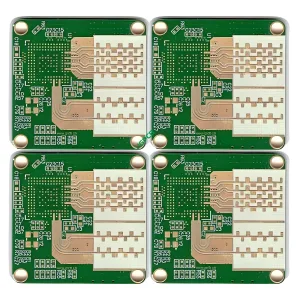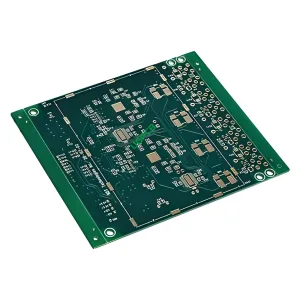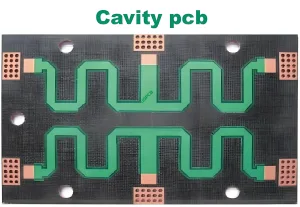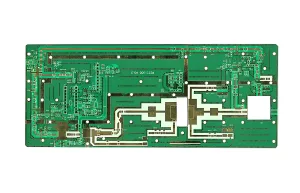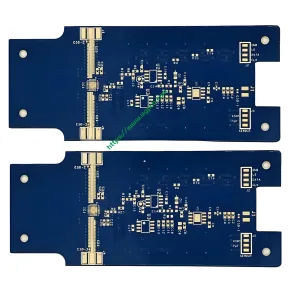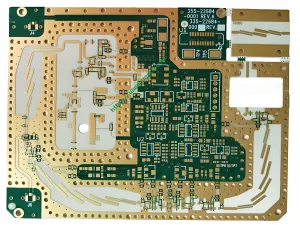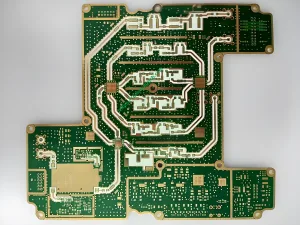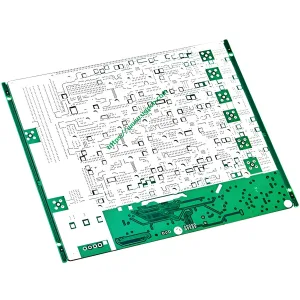Definition of High Frequency Microwave PCB
High frequency microwave circuit board refers to a special electromagnetic frequency circuit board, which is used for high frequency (more than 300 MHZ frequency or wavelength less than 1 meter) and microwave (more than 3 GHZ frequency or wavelength less than 0.1 meter) in the PCB field. CCL is a circuit board produced by using a part of the ordinary rigid circuit board manufacturing method or by using a special processing method. Generally speaking, a high-frequency PCB board can be defined as a frequency higher than 1GHz circuit board.
With the rapid development of science and technology, more and more devices are designed in the microwave frequency band (>1GHz) or even the millimeter wave field (30GHz) above the application, which also means that the frequency is getting higher and higher, and the impact on the circuit board substrate The requirements are also getting higher and higher. For example, the substrate material needs to have excellent electrical performance, good chemical stability, and with the increase of the power signal frequency, the requirements for the substrate loss are also very small, so the high frequency board is highlighted.
PCB high frequency microwave circuit board single board application field
1. Mobile communication products, smart lighting systems
2. Power amplifier, low noise amplifier, etc.
3. Passive devices, such as power dividers, couplers, duplexers, filters, etc.
4. In the fields of automobile collision avoidance system, satellite system, radio system, etc., the development trend of electronic equipment is high frequency.
Classification of high frequency microwave PCB boards
Thermoset Materials for Filled Powder Ceramics
Manufacturer: Rogers 4350B/4003C, 25N/25FR from Taconi Corporation TLG Series Arlon
Approach:
The process is similar to epoxy/glass woven cloth (FR4), but the plate is brittle and breaks easily.
When drilling holes and gong plates, the life of drill bits and gong knives should be reduced by 20%.
PTFE (polytetrafluoroethylene), polytetrafluoroethylene PCB.
manufacturer
1. RO3000 series, RT series and TMM series of Rogers Corporation
2. Arlon’s AD/AR series, Isoclad series and Cuclad series
3. Taconi RF series, TLX series and TLY series
4. Taixing Microwave F4B, F4BM, F4BK, TP-2
processing methods
1. Cutting board: The protective film must be kept to prevent scratches and indentations
2. Exercise:
A. Use a new drill bit (standard 130), preferably one in a stack, with a presser bite pressure of 40psi
B. Aluminum sheet as the cover sheet, then use 1mm 3 uramine pads to tighten the teflon sheet
C. After drilling, use an air gun to blow off the dust in the hole
D. Use the most stable drilling and drilling parameters (basically, the smaller the hole, the faster the drilling speed; the lower the chip load, the lower the return rate)
3. Hole processing
1. Plasma treatment or sodium naphthalene activation treatment is beneficial to metallization of pores
4. Parathyroid hormone
A. After micro-etching (the micro-etch rate is controlled by 20 micro inches), the board should be fed from the de-cylinder in the PTH
B. A second PTH will be done if necessary, just start with the expected margaritops jar
5. The Soldermask
A. Pretreatment: Use pickling plate instead of mechanical grinding plate
B. Pretreatment, then bake the board (90 degrees Celsius, 30 minutes), brush with green oil to cure
C. The baking pan is divided into 3 parts: one part is 80 degrees Celsius, 100 degrees Celsius and 150 degrees Celsius, and the time for each part is 30min (if there is oil spilled on the surface of the substrate, it can be reworked: wash off the green oil and restart)
6. Contour routing
Spread white paper on the surface of the PTFE board circuit, clamp the top and bottom with FR-4 substrate or phenolic substrate with a thickness of 1.0mm to remove copper: as shown in the picture:
7. Process flow
A.NPTH PTFE sheet processing technology
Data Drilling – Drilling – Dry Film – Inspection – Etching – Etching – Solder Resistance – Characters – Tin Spraying – Forming – Testing – Final Inspection – Packaging – Shipping
B.PTH PTFE sheet processing technology
Material opening – drilling – drilling treatment (plasma treatment or sodium nitride activation treatment) – copper precipitation – board electric – dry film – inspection – pull electric – etching – corrosion inspection – solder resistance – character – tin spraying – Forming – Testing – Final Inspection – Packaging – Shipping
8. Summary
Difficulties in high frequency circuit board processing
A. Copper sink: the hole wall is not easy to be copper-plated
B. Switching, etching, line width slot, sand hole control
C. Green oil process: control the adhesion and foaming of green oil
D. Strictly control scratches on PCB board in each process, etc
Why do you need to choose the right microwave PCB manufacturer?
Ordering microwave PCB boards from microwave PCB manufacturers equipped with high-tech equipment is more beneficial to low-cost PCB manufacturers using low-level materials.
Microwave PCBs are very sensitive to factors such as noise, impedance, electromagnetic and ESD. Manufacturers of high quality PCBs focus on eliminating any contributing factors in the manufacturing process. Low quality RF microwave circuit boards are not expected to be the case for long, That’s why choosing a perfect RF microwave circuit board manufacturer can change your product experience.
Today, most modern RF microwave PCB manufacturers use computer-aided engineering software analog programs for PCB fabrication. The biggest advantage of CAD-based RF microwave PCB manufacturing is that it has simulation models of various brands and PCB models with appropriate product specifications.
These parameters are critical for standardizing the production of RF microwave PCBs and ensuring reliability. In addition, these machines also support manual operation, allowing the operator to perform manual operations.
At this point, it is clear that the manufacture of RF microwave PCBs is not as simple as it seems.
Why choose UGPCB to manufacture RF Microwave PCBs?
UGPCB has provided RF microwave PCB manufacturing facilities for many years. UGPCB’s qualified professionals have PCB manufacturing expertise based on Rogers (Taconic PCB Materials). Fortunately, UGPCB has rich experience in RF microwave PCB manufacturing for communication equipment.
UGPCB is more inclined to be used in RF microwave PCB manufacturing. Various microwave PCB materials allow us to select the most suitable material according to the requirements.
The benefits of making RF microwave PCBs through UGPCB.
RF microwave PCBs are not as easy to manufacture as normal PCBs. Various factors need to be explained and monitored in detail. As an experienced RF microwave PCB manufacturer, UGPCB has accumulated extensive experience in handling RF projects and has a precise understanding of how to combine these factors. UGPCB is a world-renowned PCB manufacturing brand. High-quality products and satisfying customer experience enhance our image.
It’s hard to believe that a microwave PCB manufacturer uses your product, we truly understand this. UGPCB not only during the manufacturing process, but also provides detailed technical support even after the manufacture of the microwave circuit board
We ensure that your microwave PCB is not only manufactured, but that the product functions exactly as required. Before manufacturing, they will analyze the entire design to determine if there are any possible flaws or improvements. So, we will consider the customer’s problems and develop reliable products.
If the design lacks any specifications or required features, the UGPCB team is responsible for discussing with customers to provide alternatives. Also, customers can stay away from busy testing as our test team will perform various tests on your custom RF Microwave Circuit Board – Microwave PCB Make sure it serves its purpose.
 UGPCB LOGO
UGPCB LOGO


